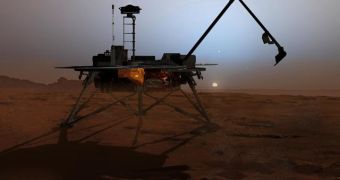The technicians in charge of the state and proper functioning of the Phoenix Mars Lander (PML) have begun the slow process of the machinery's euthanasia, turning its four heaters off one by one, starting last Tuesday. The process will go on for the following few weeks until the robotic device will eventually face a freezing doom, as the Sun will not provide enough power to fuel it. While it may sound harsh, it still allows the scientists to operate it for a little longer and conduct a few more experiments.
According to a press release issued by NASA on Tuesday, “As expected, with the Martian northern hemisphere shifting from summer to fall, the lander is generating less power due to shorter days and fewer hours of sunlight reaching its solar panels”. Phoenix Project Manager Barry Goldstein from NASA's Jet Propulsion Laboratory in California further explains the necessity of the measures taken, “If we did nothing, it wouldn't be long before the power needed to operate the spacecraft would exceed the amount of power it generates on a daily basis”.
The lander has already generously exceeded its three-month mission time by 60 days, much to anyone's surprise. During that time, it allowed for the discovery of icy and snowy states of water on the surface of the red planet. In a staggering display of usefulness, PML will attempt a swan-song before forever remaining silent, in that it will try to use its embedded microphone in order to transmit sounds from Mars.
If time and solar energy didn't come in such short supplies, perhaps the lander could have provided more evidence and samples of the opals that the Mars Reconnaissance Orbiter (MRO) has discovered on our red neighbor planet. “This is an exciting discovery because it extends the time range for liquid water on Mars and the places where it might have supported life,” shared Scott Murchie, a researcher from the Applied Physics Laboratory at the Johns Hopkins University in Maryland. “The identification of opaline silica tells us that water may have existed as recently as 2 billion years ago.”

 14 DAY TRIAL //
14 DAY TRIAL //